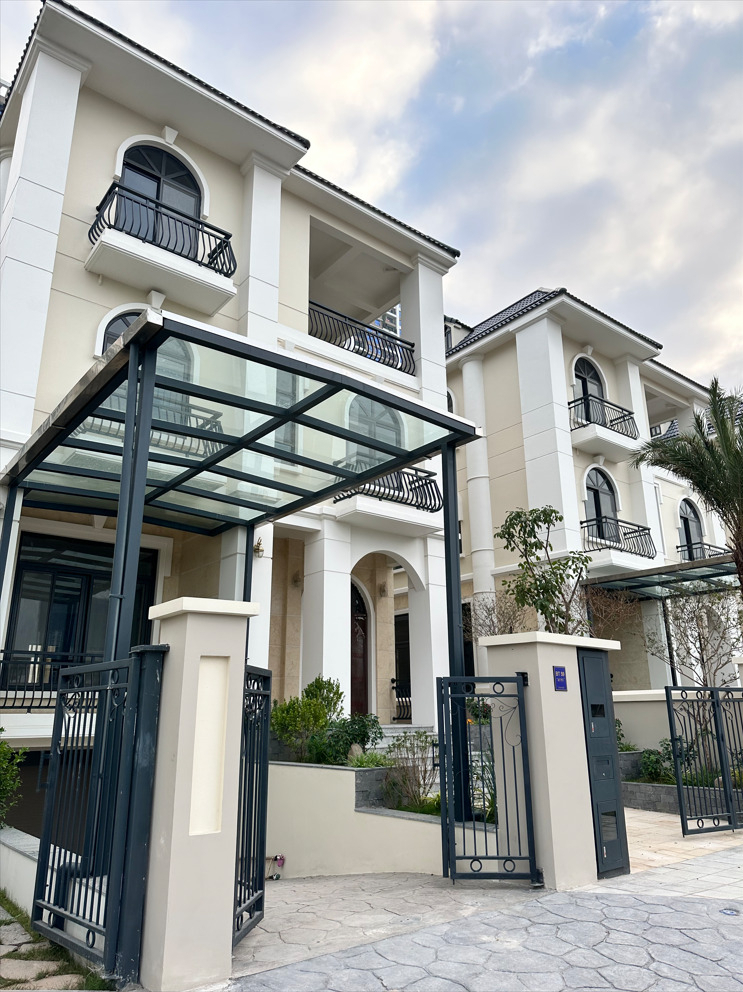 |
An aerial view of Daewoo E&C’s Starlake City in Hanoi, Vietnam (Daewoo E&C) |
Hanoi, VIETNAM -- In the heart of Vietnam’s capital Hanoi, some 5 kilometers northwest of Hanoi City Hall, lies Daewoo Engineering and Construction’s Starlake City complex of luxury residential, commercial and administrative centers around the West Lake, a spiritual place in the city.
Within an area of almost 2 square kilometers, one of the largest urban projects in the city, the South Korean builder aims to feed the dreams of Vietnamese locals who yearn to live a lavish lifestyle.
The residential bloc consists of 588 units of villas and 603 units of apartments for now. Villa and apartment residents can enjoy utilities like swimming pools, tennis courts and barber shops. Guards man the gates, offering privacy for the residents.
The four-story luxury villas feature modern European architectural design, while Vietnam’s famous palm trees are spotted among the buildings. Priced at 3 billion won-7 billion won ($2.3 million-$5.4 million) each, they were immediately sold out last year. The most expensive ones are those adjacent to the artificial lake within the city complex.
Competition to get ahold of the villas was fiercer than that for apartments, recalled an official from THT Development Co., Daewoo E&C’s subsidiary in Vietnam.
“Owning a villa means you own the land altogether, unlike an apartment which only gives you the temporary right to use the land and possess the property. These rights need to be renewed every 50 years,” said the official. “Purchasing a premium villa is a way to accumulate wealth in Vietnam that can be passed down to sons and daughters.”
 |
A luxury villa built within Starlake City in Hanoi, Vietnam (Byun Hye-jin/The Korea Herald) |
Unlike villas that have no flooring and wall finishes, the 24-story Starlake apartments are the first to adopt what the official calls “a typical Korean style interior” here. System air conditioning, white-tone kitchen cabinets and built-in dressers were installed free of charge. The apartments were sold at around 300-400 million won per unit.
“Korean style interiors are well-received in Vietnam, fueled by a craze for Korean culture spearheaded by Park Hang-seo, the head coach of Vietnam’s national soccer team, and K-pop sensation BTS,” he said.
Bilingual schools – from elementary to high schools – that teach in Vietnamese and English are scheduled to be built within the posh neighborhood.
In the commercial area, a Samsung Research and Development Center is set to complete construction this month. Other South Korean companies like CJ, E-mart and Korea Real Estate Investment and Trust will relocate their Vietnamese headquarters into the new buildings. Other occupants include Vietnamese duty-free firm Taseco and Japanese manufacturing company Toshin.
Daewoo E&C will build the Shilla Monogram, a five-star hotel brand of South Korea’s Hotel Shilla, for the first time in Hanoi as well.
The success of the Starlake City project, however, lies in whether Vietnamese government offices will relocate here, the official said. Their very existence would guarantee the value of the property, he added.
Eleven government offices are scheduled to relocate to the complex, including the Ministry of Planning and Investment, Ministry of Industry and Trade, Ministry of Construction, Ministry of Transport, Ministry of Justice, Ministry of Health and the Ministry of Education and Training.
Fifteen diplomatic delegations such as South Korea, Saudi Arabia, Iran, Hungary, Egypt, Brazil, Thailand and Myanmar embassies also will move to the city’s bloc.
“Starlake City will become the new administrative and international center of Hanoi, aligning with the Vietnamese government’s transport development strategy of building new roads and subways to reduce the severe traffic congestion,” said the official.
The history of Daewoo E&C’s Starlake City project can be traced back to 1996, when the late chairman Kim Woo-jung, who had a keen interest in making forays into Vietnam, bought a partial property site there. The project was originally aimed at changing the skyline in Hanoi, but after South Korea’s financial crisis in the late 1990s the company had a setback and changed its plan in 2006 to building a new city area.
The 19-year two-phase project is divided into the July 2010-December 2024 period and the October 2017-December 2028 period. It took a lot of time to give reimbursements to the original landowners through the municipal government, the official said. Daewoo E&C still has some 20 percent left to compensate.
The $3.2 billion business started to log sales revenue and profit starting from 2017, when the company successfully completed presales for 116 units of high-end villas after selling 182 units a year earlier.
Daewoo E&C expects construction work for its own businesses such as apartments and schools to be completed by 2028. In the residential bloc, 1,502 apartments will begin the presale process in the near future, following the second phase plan.
Other projects that involve third parties like Vietnamese government offices or global companies may take longer until a grand opening, the official said.
The size of Vietnam’s infrastructure industry is estimated at $5.2 billion as of this year, which is forecasted to expand to $11 billion by 2030, according to a report from the Korea Trade Promotion Corporation. Driven by burgeoning demand for urban infrastructure development such as transportation and hygiene and power shortage issues amid rapid industrialization, the country is expected to see continuous investment in those areas, the KTPC said.






![[Today’s K-pop] Blackpink’s Jennie, Lisa invited to Coachella as solo acts](http://res.heraldm.com/phpwas/restmb_idxmake.php?idx=644&simg=/content/image/2024/11/21/20241121050099_0.jpg)
